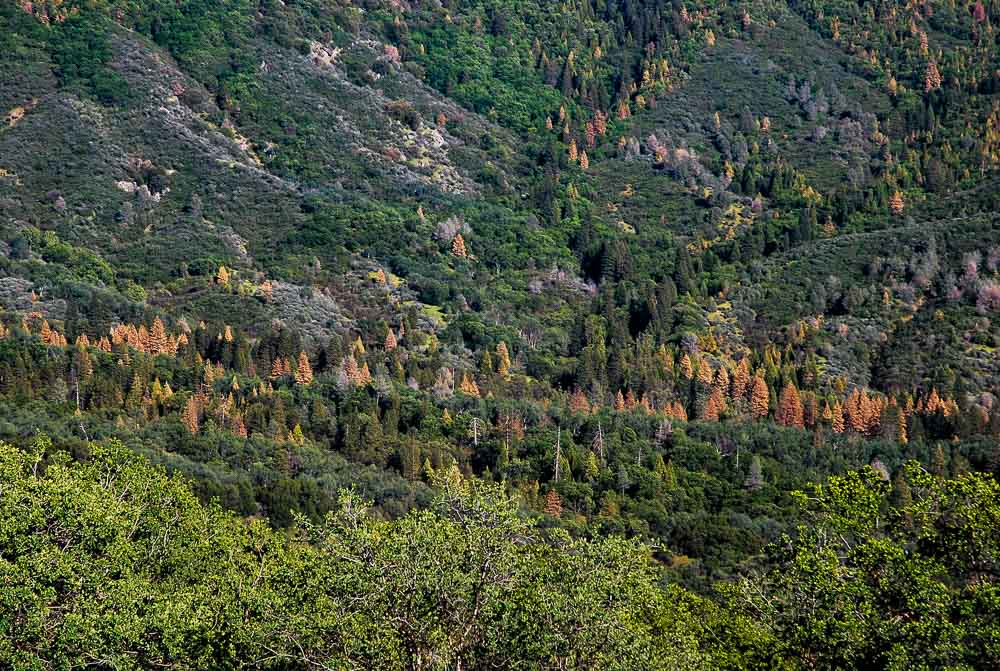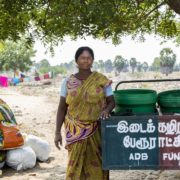California Fire Danger Mounts in Sierra Nevada Forests
Bark beetles, water scarcity, and dying trees herald a region in ecological transition during the height of state’s four-year drought.

On every steep slope within view are large clumps of dead ponderosa pines, the signature trees of the Sierras, the needles on their topmost branches turned the color of dried blood. Photo courtesy US Forest Service
JAMESTOWN, Ca. – During the July 4 weekend, the U.S. Forest Service issued urgent instructions to hikers and campers to be exceedingly cautious in lighting campfires across California’s tinder dry Sierra Nevada mountain range. Embers that escaped almost two years ago from a campfire in the thickly wooded slopes east of this Gold Rush era town ignited the 104,000-hectare (257,000-acre) Rim Fire that burned for two months and is ranked by Cal Fire, a state firefighting agency, as the third largest wildfire in California’s history.
All across the 640-kilometer (400-mile) Sierra range, which runs nearly the length of California’s eastern border, state and federal forest agencies are preparing for a miserable season of fire. The same is true across much of the American West and Alaska where winter snows, and spring and early summer rain, have been scant.
Wildfire Alert
Already this year, nearly 50 large fires have erupted across the West since January, according to the National Interagency Fire Center, a federal firefighting coordination group. In San Bernardino County, California, the Lake Fire ignited on June 7, burning over 12,500 hectares (31,000 acres), and was still not extinguished as of mid-July.
Almost all of the 1.25 million hectares (3.1 million acres) consumed in the first six months of 2015 have been in Alaska, California, and the Rocky Mountain states. That is 38 percent more fire-ravaged forest than the average of 906,000 hectares (2.24 million acres) that burned from January to late June in each of the previous 14 years.
In addition, hundreds of smaller fires are tracked by Inciweb, a national fire reporting service. Three fires are burning in southern California in the San Bernardino and Sequoia National Forests.
Firefighting authorities say the dry conditions, coupled with 70 years of suppressing forest fires in California and across the West, have aggravated the risk of bigger, hotter, and more dangerous fires. The Sierra’s forests have more trees much closer together than they did before the obsolete fire suppression policy was lifted in the 1970s, and a different approach was instituted that largely focused on containing the big fires to protect homes.
Last year, severe wildfires compelled California Democratic Governor Jerry Brown to declare a state of emergency. This year, the governor said he expects worse and in April told reporters, “We’re in for tough times.”
A Changed Landscape
In mid-June, Beverly Bulaon, an entomologist with the U.S. Forest Service based in Sonora, showed a Circle of Blue correspondent the effects of the drought and the high risk of fire in the 363,000-hectare (898,000-acre) Stanislaus National Forest, which borders Yosemite National Park and is spread across much of Tuolumne County.

Beverly Bulaon, an entomologist with the U.S. Forest Service based in Sonora, studies the changes in the Sierra forests prompted by the four-year drought. “I’m in awe at the way the Earth is trying to balance itself,” she said. “It’s a wonder at the way that the ecosystem is trying to correct itself. What’s amazing is that it’s doing it all naturally.” Photo by Keith Schneider / Circle of Blue
Bulaon was born in the Philippines, raised in the San Francisco Bay Area, trained at Humboldt State University in California’s North Coast, and has spent 15 years as a Forest Service insect scientist. She served initially in Montana before returning to California.
Bulaon’s view of the changes the drought has imposed on the Stanislaus forest are deeply influenced by her scientific training, and her heart.
“It does seem sad,” she told Circle of Blue. “You know, at the same time a lot of the pines, because we suppressed fire for so long, have encroached in on the meadows where there weren’t pines before.”
She explains that the forest in this part of the Sierras looks much different than it did in 1865 when Mark Twain spent a winter near what is now Angels Camp, a few miles from here, and later wrote “The Celebrated Jumping Frog of Calaveras County,” the short story that made his career.
“Fire intervals, which is how often fire happens in an area, could have been 5 to 25 years under natural conditions,” Bulaon continued. “That’s how often these forests would have burned. Burning reduces tree density. There were a lot less trees than there are now.

Cottonwood Creek, in the Sierras near Yosemite National Park, is normally a whitewater torrent in early summer. This year it meanders gently in a mostly dry riverbed caused by California’s deep drought. Photo by Keith Schneider / Circle of Blue
As the forest makes its transition, as tightly packed trees give way to wider spaces and the return of forest meadows, the conditions are nevertheless illustrated by a tableau of stress and death and danger.
Effects of Drought
Bulaon showed how drought has weakened adult trees, making them vulnerable to bark beetles and diseases that are fatal. After they die, ponderosas take more than a year to turn from green to red. The newest patches of red trees died last year. Thousands more trees will die this year and show their dead needles next year. Live ponderosas are the most fire-resistant trees in this region of the forest. Dead ponderosas are now energy-rich fuel for fires.
“We don’t have fall colors here,” Bulaon said, calling attention to a slash of red on a distant slope. “Those are dead trees. This kind of mortality isn’t brand new. It’s just that the patches of dead trees have gotten bigger. Large patches of trees are dying all at once.
“Before, we might have seen activity here and activity there. Now those areas are starting to blend in together. The drought is getting more severe. A lot more trees are dying. It’s only June. We expect what we see on the landscape to get significantly worse this year.”
Other drought-related changes in the forest involve insects and different species of trees. Bark beetle infestations are growing worse, killing many more trees as the drought weakens the ponderosa’s natural defenses.

New Melones Lake, opened in 1979 in the Sierra foothills near Jamestown and California’s fourth largest reservoir, is 15 percent full and dropping nearly 2,000 acre-feet a day. Photo by Keith Schneider / Circle of Blue
The more treacherous conditions, though, are not slowing the migration of new residents to Sierra counties, or the desire to build expensive homes in the forest. Tuolumne has 54,000 residents, twice as many as in 1977.
The battle to contain wildfires is largely a struggle to protect property, and it is costly. During the 2007-2008 fire season, the last period of serious drought, Cal Fire spent a record $US 524 million on fire fighting. In 2010-2011, the wet year before the start of the current drought, it spent $US 90 million. Last year, firefighting cost the state $US 209 million.
Climate change is likely to increase that budget substantially.
“We really need to prepare for drier conditions over the long term,” said Bulaon. “What happens in the next 50 or 100 years? Just look at what is happening now. All of this dead fuel in the forest. The possibility of a fire is always on your doorstep. Right now a lot of the Stanislaus National Forest could burn up any minute.”
Circle of Blue’s senior editor and chief correspondent based in Traverse City, Michigan. He has reported on the contest for energy, food, and water in the era of climate change from six continents. Contact
Keith Schneider













Leave a Reply
Want to join the discussion?Feel free to contribute!